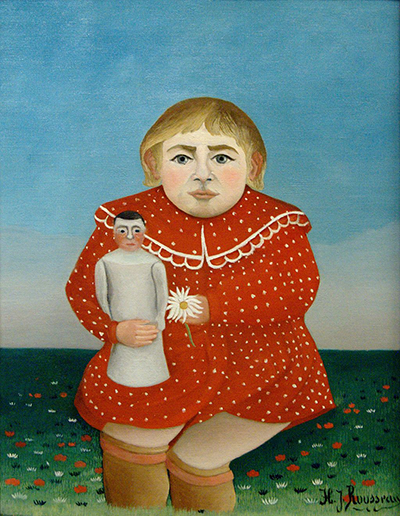It is an oil on canvas painting made by Henri Rousseau around 1892 and measures 67cm by 52cm without the frame and 88cm by 72.5cm with its frame. This awesome piece of art is currently held at Orangerie Museum for preservation and exhibition.
Rousseau painted this piece when he was 62, 4 years before his death. This painting was a from of distorted figure as the child’s body is bloated and her face seems to be compressed and her legs forming an awkward, if not a downright impossible posture. Upon further investigation, the painting makes you wonder if the child is sitting or standing in the grass as the re was no seat or chair incorporated in the painting.
The child’s body is a representation of the Egyptian" style of painting, where the upper body appears in front with legs in profile. The modeling is practically non-existent and the white polka dots that embellish the child's dress further emphasise the plainness of the character who seems literally glued to the background.
The landscape in the background is overly simplified to the extreme with a meadow strewn with flowers suggestive of medieval tapestries and an almost uniform blue sky. Rousseau creates a small effect of perspective by making the grass a bit darker to be better seen from a distance and by reducing the size of the daisies. Additionally, Henri paints a shadow under the girl’s buttocks in the form of illuminations.
In this piece of art, Rousseau rediscovers the aesthetics of the Italian or French "primitives" at a time overly populated with primitivism of all sorts. This formed an important facet of his art that inspired his contemporaries and which made André Lhote (1885-1962) calim that in the Middle Ages, Rousseau’s paintings delighted the crowds. Arsène Alexandre (1859-1937) also claimed that Rousseau’s paintings were the “the Paolo Uccello of our century."
This type of unusual poses was more of a trademark for Rousseau’s trademark and was incorporated in most of his paintings. The deep colour contrasts in this painting is very start as the child looks sad and body is disproportional compared to the normal child’s physique. Additionally, her legs that disappear in the grass also look mysterious as they are bigger than other body parts like her arms further contributing to the child’s overall unchild-like look.
Final Thoughts on the Artist and this Painting
It is believed that Henri had a particular aversion to painting feet, and in this painting where the we see the child tightly holding tightly on her beloved doll, which has turned a shade of grey, probably from constant handling. L'Enfant a la Poupee by Henri Rousseau can be categorized as a simplistic painting that lack in-depth details an interpretations but not at the expense of its sheer beauty and prowess.




